Hurricane Laura: the 'unsurvivable' storm surge that went astray

Storm surge is the biggest threat to lives and homes in coastal regions during the hurricane season. An “unsurvivable” six-metre storm surge was predicted for Hurricane Laura in August. The damage was far less than feared, but it turns out the prediction was not overstated.
Storm surge is a steady rise in the sea level along the coast in addition to normal tides, caused by a combination of water piled up by wind and low air pressure. The size and strength of the hurricane determine the height of the surge. Hurricanes are circular storms, so the surge occurs on the side where winds are blowing towards the shore, highest where the winds are strongest. The topography of the coastline affects the surge. Bays or rivers funnel a higher storm surge and make it greater, a steep drop-off between land and seabed reduces it.
Surge height is therefore highly dependent on the exact location of landfall. With Laura, densely populated areas escaped relatively lightly, though the surge still broke records.
Damage assessment carried out in September by the National Weather Service explored sparsely inhabited swamplands further down the coast. They found mud and debris six metres up in trees, indicating that the surge had indeed occurred as predicted, just not at the feared location.

 Yahoo News
Yahoo News 